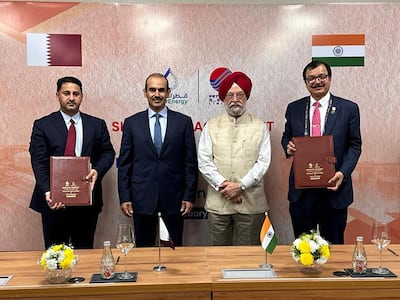QatarEnergy has signed a 20-year sales and purchase agreement with India’s Petronet LNG to supply 7.5 million tonnes per annum (mtpa) of liquefied natural gas.
Starting from May 2028, contracted volumes of the fuel from Qatar will be delivered directly to terminals across India by QatarEnergy's LNG fleet, the state-run energy company said in a statement on Wednesday.
“This agreement is another key milestone in the long-standing energy partnership between Qatar and India,” said Saad Al Kaabi, president and chief executive of QatarEnergy.
The new agreement will “further strengthen the relationship with India and support its vision to increase the contribution of natural gas in its energy mix”, Mr Al Kaabi said.

Petronet first entered into an agreement for the supply of LNG from Qatar in 1999 for the delivery of 7.5 mtpa. It was followed in 2015 by another agreement for the supply of an additional 1 mtpa of LNG, raising the total annual long-term volumes contracted to 8.5 mtpa.
Petronet LNG is a joint venture with equity from four Indian state-owned energy companies.
Gas Authority of India Limited (GAIL), Oil and Natural Gas Corporation (ONGC), Indian Oil Corporation (IOCL), and Bharat Petroleum Corporation (BPCL), each hold a 12.5 per cent stake in the company.
The volumes under the new LNG agreement will be off-taken by GAIL, IOCL, and BPCL primarily from Petronet LNG’s Dahej terminal in the western Indian state of Gujarat, BPCL said in a separate statement on Wednesday.
The existing long-term agreement between Petronet LNG and QatarEnergy accounts for about 35 per cent of India’s LNG imports, BPCL said.
India, Asia's third-largest economy, aims to increase the share of natural gas in the country's total energy mix to 15 per cent by 2030, from about 6 per cent currently.
Last month, Adnoc Gas signed a 10-year agreement to supply 500,000 mtpa of LNG to GAIL.
India currently relies heavily on coal to generate electricity.
The country added an annual average of five gigawatts of coal-based electricity generation capacity from 2017 to 2022.
“India holds significant potential to regional gas demand growth, but gas demand growth will remain constrained by the lack of adequate supplies,” BMI said in a research note.
The country is expected to contribute about 20 per cent of Asia’s additional natural gas consumption between 2023 and 2033, the research firm said, adding that demand would be supported by power and industrial sectors.




